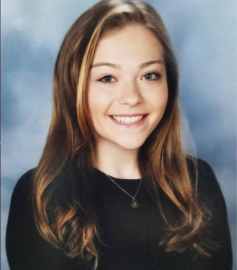- About Us
- Advertise / Support
- Editorial Board
- Contact Us
- CancerNetwork.com
- TargetedOnc.com
- OncLive.com
- OncNursingNews.com
- Terms & Conditions
- Privacy
- Do Not Sell My Information
- Washington My Health My Data
© 2025 MJH Life Sciences™ and CURE - Oncology & Cancer News for Patients & Caregivers. All rights reserved.
Tafinlar Plus Mekinist Shows Benefits In Pediatric Glioma

Rylan DeStefano is an assistant editor working for CURE®, and has been with MJH Life Sciences since June of 2023. Rylan is a graduate from Muhlenberg College. When she’s not writing, Rylan loves to read, travel and spend time with family and friends.
A recent phase 2 trial revealed that the combination of Tafinlar and Mekinist benefitted children with BRAF-mutated low-grade gliomas.
A recent phase 2 trial revealed survival and side effect improvements of children patients with BRAF-mutated low-grade pediatric gliomas when being treated the combination of Tafinlar (dabrafenib) plus Mekinist (trametinib).
These trial was led by UCL and Great Ormond Street Hospital.
Gliomas start in the glial cells, which support the brain. The cancerous brain tumorous are typically treated with a full surgical removal. Chemotherapy is also an option for children when surgery isn’t possible, although treatment through chemotherapy may conclude in disease progression and other side effects.
“New treatments that help improve outcomes and reduce side effects for young patients living with BRAF V600 low- and high-grade gliomas address unmet patient need, where treatment options are very limited,” noted Gerrit Zijlstra, chief medical officer, Novartis UK, in a press release.
The TADPOLE-G study focused on the benefit of combining the two therapies for treatments within children patients with BRAF-mutated low- and high-grade pediatric gliomas. These results were published in the New England Journal of Medicine and the Journal of Clinical Oncology.
The trial consisted of 73 children with BRAF-mutated low-grade gliomas (BM-LGG). This patient’s population was treated with Tafinlar and Mekinist. These individuals were then compared to a subgroup that was treated with chemotherapy drugs.
The progression-free survival (the time from randomization of treatment to disease progression or death) median improved from 7.4 months with chemotherapy to 20.1 months with new treatment. The study also revealed the drug combination not only reduced chemotherapy side effects within this patients population, but the overall response rate had resulted in a four-fold improvement (four times greater).
“We welcome the results of the TADPOLE-G clinical trial and are humbled to be a part of an international scientific community effort in developing targeted therapies based on the unique genetic features of a patient’s tumor” noted Zijlstra.
Another study analyzed children with BRAF-mutated high-grade gliomas (BM-HGG).
Children diagnosed with high-grade gliomas typically undergo surgery followed by chemotherapy and radiotherapy combinations. Although this was investigated, only about one in five children benefit from this treatment, the survival rate being below 35%. These individuals also experience the possibility of cancer recurrence.
The second study conducted analyzed 41 pediatric patients who had treatment for BM-HGG. The treatment had resulted in 56% of these patients responding positively, with a median response of 22.2 months.
These results concluded that the combination therapy could benefit patients by becoming a first-line treatment for patients with BM-LGG. Notably, Tafinlar plus Mekinist has already been FDA approved for patients with BM-HGG.
READ MORE:FDA Approves Tafinlar Plus Mekinist for Pediatric Brain Tumors
“The results of these studies highlight how targeted drug therapies can offer patients new treatment avenues that not only improve outcomes but reduce the side effects often associated with cancer therapies,” noted Professor Darren Hargrave from UCL Great Ormond Street Institute of Child Health and GOSH.
Tafinlar and Mekinist have shown benefits within the oncology field, now being used to treat melanoma and non-small cell lung cancer in patients with BRAF gene mutations.
“It has been incredible to watch research move our ability to treat specific cancers forward at such a rapid pace. I was involved in the original study that identified BRAF gene mutations as drivers of cancer and so it has been fantastic to now be able to see treatments that target the mutation in clinical trials for pediatric gliomas,” said Hargrave.
For more news on cancer updates, research and education, don’t forget to subscribe to CURE®’s newsletters here.
Related Content:



